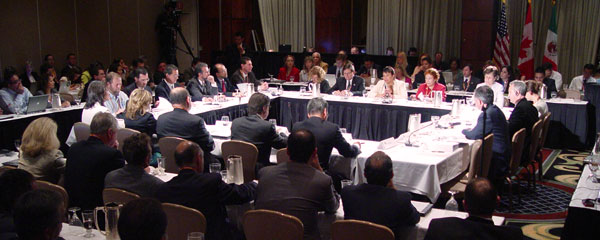People from all around the continent really should take advantage of the Joint Public Advisory Committee hearings Oct. 17 and 18 in Washington D.C. to tell the trinational North American Commission for Environmental Cooperation (CEC) what they think it should do after 20 years in existence.
 Nobody has to go to the meeting in the U.S. capital to take part: It will be open to everybody in Mexico, the United States and Canada, via webcast.
Nobody has to go to the meeting in the U.S. capital to take part: It will be open to everybody in Mexico, the United States and Canada, via webcast.
This kind of openness has marked the CEC since its establishment as a requisite for U.S. government approval of the North American Free Trade Agreement in 1994.
Having the Montreal-based commission in place has provided many an opportunity for pluralistic input into federal decision-making, even when the individual governments of the three countries involved have been closed to their own citizens.
It also has provided a model for other countries in the Americas as they develop trade agreements and environmental standards that aim to level the playing field for business and health.
The CEC is a tool for environmental justice and we will either use it or lose it.
Folks taking part in the hearings should make sure it persists by recommending that more money be allotted to the many programs at the CEC.
Time and again, the individual governments in the NAFTA treaty have balked at continuing their $3-million annual respective support for the CEC, so telling the environmental ministers to support and increase funding is of paramount importance.
What’s more, input about ways to improve the CEC’s effectiveness should be offered in this forum for constructive criticism.
The Joint Public Advisory Committee (JPAC) says it wants to know what the public thinks the commission has done well and what it can do better.
The CEC’s all-important nurturing of citizen input has borne healthy fruit in numerous areas.
Outstanding among them are the successful efforts to make mandatory industrial pollutant reporting comparable across political boundaries, to investigate and release public reports on citizen complaints of environmental law breaking, and to provide funds for local sustainability projects that adhere to a trinational perspective on mitigating the harmful effects of global trade.
Much of the impact of this work is realized through communications media’s use of the results.
In fact, without media involvement, decision-makers would have little knowledge of the toxic hotspots and hazardous waste tracks revealed by the North American Pollutant Release and Transfer Registers.
By the same token, the commission’s findings of fact on citizens’ submissions about enforcement matters under the CEC’s Articles 14 and 15 covering NAFTA parties’ failures to follow their own environmental laws would not come to light, much less inspire corrective measures.
The $1.2-million in competitive grants available for green grassroots initiatives would go unpublicized and the recipients of funding would toil in isolation and anonymity.
Based on their exposure in the media or on personal online casino experience, people who testify in the hearings can bring up positive examples of how CEC efforts have resulted in a better environment. For example:
* Mexico now has legislated a mandatory industrial pollution register, thanks to the citizen involvement supported by the CEC;
* A toxic waste dump in a Tijuana neighborhood was cleaned up, thanks to use of a factual record the three NAFTA countries’ environmental ministers allowed to go public;
* Indigenous communities far and wide are using solar ovens to save energy and prevent wood-fire smoke inhalation problems, thanks to the grants of the North American Partnership for Environmental Community Action.
The CEC could get more bang for the buck by dedicating more of the funding, outreach and policy to media involvement.
The 20th anniversary of the CEC will almost certainly revive the old argument about whether to increase the commission’s enforcement powers. Whether or not they get a boost, the only certainty is that news coverage of the trinational environmental body will make or break it.
The Fourth Estate is the lynch pin between officialdom and democratic participation.
Unfortunately, many journalists, including those who specialize in the environmental beat, don’t know about the CEC and don’t follow its activities.
On that note, public testimony could push the ministers of the CEC to direct the staff to enhance the media link potential in all its programs and projects.
The environment ministers should be encouraged to channel global development funding to this cause.
Even without an injection of new money, imagine what could be accomplished if the CEC were to form a partnership with the environmental journalists’ networks in the three North American countries.
The CEC could train network members on the tools the commission is creating to provide unprecedented access to environmental information.
In turn, network members could train others in their professional associations.
What’s more, these journalists would get the information out to the public and decision makers in ways that have never been seen before.
The three governments would be missing a big opportunity by overlooking this potential of the CEC. On the other hand, if they heed the call, the environment, public health, and hence, the economy, would profit.
Talli Nauman is an environmental journalist and organizer, co-founding member of the Mexican Environmental Journalists Network and columnist for the CIP Americas Program www.americas.org



